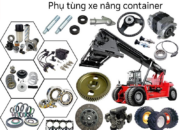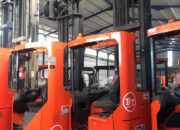Trends and New Technologies in the Forklift Industry
- Introduction
The forklift industry has witnessed significant developments recently, driven by emerging trends and new technologies. This has spurred improvements in efficiency and safety in material handling operations. In this article, we will briefly overview some important trends and technologies in this field.
- Trends in the Forklift Industry
Automated Guided Vehicles (AGV) and Autonomous Mobile Robots (AMR): AGV and AMR are becoming crucial trends in the forklift industry. They have the capability to automate material handling processes, reducing reliance on labor and enhancing productivity.
All-Electric: The shift from internal combustion engine forklifts to electric forklifts is gaining popularity. This not only reduces emissions but also lowers operating and maintenance costs.
Integration of IoT and Analytics: The integration of the Internet of Things (IoT) into forklifts allows real-time monitoring, management, and optimization of operations. Analytics helps predict and prevent incidents, improve forklift selection, and schedule maintenance.
III. New Technologies in the Forklift Industry
Advanced Battery Types: Battery technology is advancing, enabling forklifts to operate for longer periods and charge faster. Lithium-ion batteries, in particular, are favored for these features.
Automated Guided Systems (AGS): AGS technology enables forklifts to autonomously navigate and avoid collisions, optimizing operations and ensuring safety.
Adaptive Solutions: Adaptive technologies like automatic balancing systems and remote control are becoming integral parts of forklifts, reducing incidents and improving operational capabilities.
- Benefits of New Trends and Technologies
Improved Efficiency: New technologies enhance performance and accuracy in material handling.
Higher Safety: Integration of safety systems and autonomous navigation reduces the risk of accidents and worker injuries.
Cost Savings: Electric forklifts, IoT integration, and analytics help reduce operating and maintenance costs.
Environmental Protection: Switching to electric forklifts and reducing emissions contributes to environmental protection.
- Conclusion
The forklift industry is rapidly evolving with the emergence of various trends and new technologies. Importers and distributors of forklifts need to stay updated on these developments to provide the best solutions to customers and remain competitive in this increasingly competitive market.
What Are Autonomous Guided Vehicles (AGV) and Autonomous Mobile Robots (AMR)?
Autonomous Guided Vehicles (AGV) and Autonomous Mobile Robots (AMR) are two types of forklifts designed to operate without human intervention. However, they differ in their operation and primary applications:
Autonomous Guided Vehicles (AGV):
AGVs are forklifts that operate based on fixed guidance systems.
They are controlled by adhering to a fixed guidance system such as wires embedded in the floor, markers, or directional sensors.
AGVs are typically used in environments with fixed paths and structured material handling operations, such as manufacturing plants and warehouses.
Autonomous Mobile Robots (AMR):
AMRs are forklifts that operate without the need for fixed guidance systems.
They are equipped with sensors and intelligent systems to autonomously move, interact with the environment, and perform tasks through programming or remote guidance.
AMRs offer more flexibility in operating in dynamic environments and do not require changes to infrastructure to install guidance systems.
Both types of forklifts have the capability to optimize material handling processes, reduce dependence on labor, and enhance productivity in industrial environments. The choice between AGVs and AMRs often depends on the specific requirements of the application and the working environment.
Electric Power and the Future of Battery Technology
The development of electric power and battery technology is having a significant impact on various aspects of modern life, from powering handheld devices to renewable energy sources and electrical transmission systems. Here are some trends and prospects in this field:
High-Performance Batteries: Research into new battery types, such as lithium-sulfur and fuel cell batteries, is ongoing to create batteries with larger capacity and higher efficiency. This will improve the usage time of mobile devices and reduce charging time.
Battery Reuse and Recycling: Battery reuse and recycling technologies are advancing to reduce the waste generated by lithium-ion batteries and protect the environment.
Fuel Cell and Hydrogen Batteries: These technologies are becoming more important in the transportation and renewable energy industries. Fuel cell batteries have the potential to provide continuous energy and replace traditional energy sources like gasoline, diesel, and coal.
Energy Storage and Large-Scale Battery Systems: Advances in energy storage technology and large-scale battery systems help efficiently integrate renewable energy into the grid, reducing the impact of climate change and providing more stable energy sources.
Battery Management Technology: Battery management technology will become increasingly important in optimizing battery performance and lifespan, especially in critical applications like electric vehicles and energy storage.
Fast and Wireless Charging Technology: Fast and wireless charging technology is rapidly developing, saving users time and increasing the convenience of charging batteries.
The future of electric power and battery technology promises cleaner and more efficient energy sources, contributing to a more sustainable living environment.
Integrating IoT and Analytics into Forklifts
Integrating the Internet of Things (IoT) and data analytics into forklifts has become a crucial trend in the industrial and transportation sectors. Here’s how the use of this technology can improve performance, safety, and management in material handling operations:
Real-time Sensor Data Collection: Forklifts can be equipped with sensors to gather information about operational aspects such as load capacity, location, speed, and temperature. This data can be transmitted via the IoT network for real-time monitoring and analysis.
Optimizing Scheduling and Warehouse Management: Data from forklifts can be used to optimize work schedules, ensuring that material handling tasks are performed efficiently and promptly. Data analytics can identify areas for improvement and optimize inventory management.
Predictive Maintenance: Analyzing data from sensors on forklifts can help predict when maintenance or component replacement is needed. This minimizes downtime and unplanned repairs.
Enhancing Safety: IoT can be used to monitor driver behavior and identify potential hazards or collisions. Automated warning and reporting systems can reduce the risk of accidents.
Asset Management: IoT enables the tracking and management of an entire forklift fleet. This improves asset utilization, optimizes allocation, and reduces losses or misuse.
Integration with Comprehensive Management Systems: Data from forklifts can be integrated into a company’s overall management system, enhancing monitoring, reporting, and overall management.
Integrating IoT and analytics into forklifts brings numerous benefits, including improved efficiency, cost reduction, enhanced safety, and optimized management. This modernizes and enhances the competitiveness of material handling operations in industrial and commercial environments.







